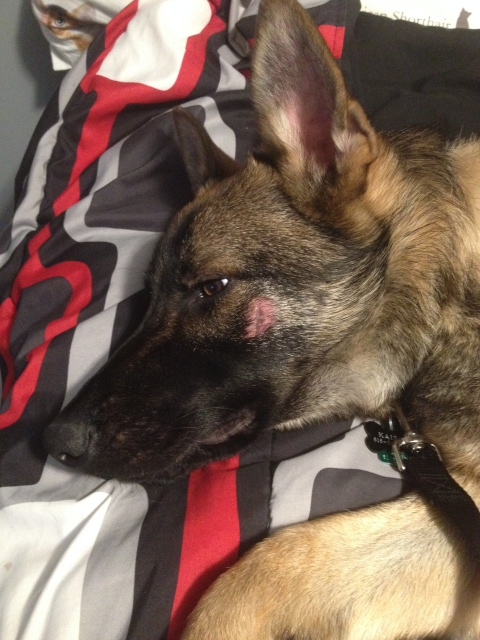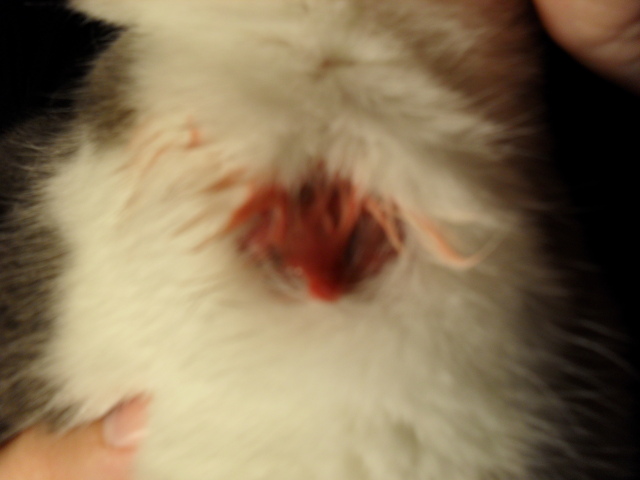QuestionQUESTION: My cat was diagnosed with a yeast infection in her ears in late September. Her
vet gave her Tresaderm which seemed to be working, but after a week she
developed an allergic reaction (lots of vomiting, rash on her ears and face)
which subsided as soon as the Tresaderm treatment was stopped.
About two weeks later I took her for a follow up vet visit, and the yeast
population was still very high. I asked for a drug-free strategy and the vet
instructed me to treat her ears with diluted vinegar. He also asked if I had
changed her diet before the yeast infection appeared, and in fact I had
switched the kibble portion of her diet a few weeks before. So the vet also
told me to switch back to her previous kibble.
It is now about six weeks later. I treated her ears almost daily with diluted
vinegar for about four weeks, and I also used aloe vera gel on q-tips to clean
out the ear wax (only her outer ears, I never put q-tips into her ear canals).
The ear wax amounts have gone done a lot, but still persists. I clean out some
ear wax about every three days now. And I rarely see her scratching her ears
anymore. Aside from the persisting ear wax, she seems to be a happy and
healthy cat ... playful, content, and very affectionate.
So my question is, am I on the right track? I've read it can take 6-8 weeks for
a food allergy to subside, so can I still work with the theory that she was
allergic to the other kibble? When should I start looking for other possible
allergens? And is cleaning her ear wax with aloe every few days an OK way to
manage the problem for now?
I know that food allergies are the most common cause of ear yeast, but can I
run a few other theories past you? A friend told me her 5 yr old cat gets itchy,
waxy ears every fall, so her vet has diagnosed a seasonal allergy. She used to
take her cat for benadryl treatments, but now she just does nothing and lets
the problem clear up by itself. Could this also apply to my cat, who has been
having this problem since late-September (now Dec 2)? I adopted her less
than a year ago, so I don't know how her ears were last fall. Also, my cat was
treated with Clavamox for a bladder infection a few weeks before the yeast
infection appeared. She also had a bad reaction to Clavamox (vomiting,
lethargy, loss of appetite). Could the antibiotic have contributed to the yeast,
the way it can in humans?
Thank you for reading such a long note.
ANSWER: Yeast infections in the ears are really rare in cats. THey do get yeast in their ears, but mostly the non-pathogenic kind. Unlike dogs, cats get waxy ears when they have seasonal allergies. If the vinegar is helping and it is subsiding without any other treatment, then your cat probably has a seasonal allergy. We do not see otic yeast infections from antibiotics. The neomycin in tresaderm is notorious for causing a topical irritant reaction in cats' ears.
I will also comment that urinary tract infections are also very rare in cats and if your cat has a urinary infection, then there may be something wrong with the kidneys causing a dilute urine or the structure of the urinary bladder is compromised in some way. Your vet will need to investigate that.
---------- FOLLOW-UP ----------
QUESTION: Dr. Gotthelf, thank you so much for a thorough answer.
I was relieved to see the word "non-pathogenic." So far I like and trust my vet,
but sometimes he seems to say "no big deal" and "your cat might be gravely
ill" all in the same sentence, so I was unsure of the correct amount of
concern.
My follow up question: if the ear wax persists beyond a date when winter
temperatures would rule out a seasonal allergy, what would be the next most
likely explanations? Or rather, is there any circumstance when waxy ears in an
otherwise healthy cat would warrant a trip back to the vet?
Regarding the bladder infection, I have an easy explanation. I was trying to
toilet train her. I tried for about 3 weeks even though she was visibly
reluctant to use the toilet. Sometimes she held her urine for almost 48 hours.
When the infection appeared (very frequent peeing, constantly licking her
backside) I gave her back the litterbox and took her to the vet.
Thank you again.
AnswerCats may have seasonal allergies, but they may also have year round allergies to things in their environments, like house dust mites, indoor molds, and other animal dander. Cats with waxy ears can have their ears cleaned periodically, but if the cat is not showing any symptoms, then don't rock the boat.

 Dog Mange
Question
Mange Mange 2
Hello!
I have a qu
Dog Mange
Question
Mange Mange 2
Hello!
I have a qu
 Cyst/bump on my cat
Question
Peters lumps/bumps
I have two male neutered Si
Cyst/bump on my cat
Question
Peters lumps/bumps
I have two male neutered Si
 Guinea Pig Eyes
Question
Bad Eye
Hello, yesterday we purchased a
Guinea Pig Eyes
Question
Bad Eye
Hello, yesterday we purchased a
 lactating dog
QuestionQUESTION: I am concerned with our 2 year old la
lactating dog
QuestionQUESTION: I am concerned with our 2 year old la
 My Cat Has some kind of abrasion
Question
The abrasion
I noticed my cat had some
My Cat Has some kind of abrasion
Question
The abrasion
I noticed my cat had some